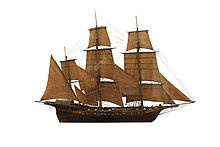Xebec
| Xebec | |
|---|---|
MENA states Sometimes used in Europe | |
| Specifications | |
| Mass | 100–200 tons, in some cases up to 600 t |
| Crew | 90 to 400 |
A xebec (
Description
Xebecs were ships similar to
Use by Barbary corsairs

These ships were easy to produce and were cheap, and thus nearly every corsair captain (Raïs) had at least one xebec in his fleet. They could be of varying sizes. Some ships had only three guns[4] while others had up to forty.[5] Most xebecs had around 20–30 cannons, and the overwhelming majority had swivel guns equipped.[6][7]
After the 18th century, galleys became increasingly outdated and xebecs became the preferred ships of Barbary pirates[8] thanks to their heavy and effective use of wind power, reduced need for slaves to row, ability to carry more cannons than a galley, and overall cheapness, speed,[9] and maneuverability.[10]
Xebecs were generally faster than contemporary ship types until the introduction of steamships.
Corsairs built their xebecs with a narrow floor to achieve a higher speed than their victims, but with a considerable
The use of square rig among pirates was initially rare, although after the 1750s a mix between lateen and square rigs became much more widespread.[10]
Use by European powers
Some victorious xebecs of the Spanish Navy, about 1770 (see Antonio Barceló campaigns... in the Spanish version of the page of Wikipedia):
- Andaluz, 30 guns (4 × 8-pounders)
- Africa, 18 guns (4-pounders)
- Atrevido, 20 guns
- Aventurero, 30 guns (3 × 8-pounders)
- Murciano, 16 guns, 4 pedreros (light swivel guns)
- San Antonio
Notable xebecs of the French Navy include four launched in 1750:
- Ruse, 160 tons, 18 guns
- Serpent, 160 tons burthen, 18 guns
- Requin, 260 tons burthen, 24 guns
- Indiscret, 260 tons burthen, 24 guns

In the eighteenth and early nineteenth centuries, a large
The British brig-sloop

Etymology
Xebec is also written as xebeck, xebe(c)que, zebec(k), zebecque, chebec, shebeck (: sunbeki).
Words similar in form and meaning to xebec occur in Catalan, French, Spanish, Portuguese, Italian, Arabic and Turkish. The
See also
References
- ^ "Chébec : Maquette de bateau historique signée Historic Marine".
- ^ Olivier d 'Orbcastel, Chebec – Slaves of the Barbarians in Algiers
- ISBN 978-0-8050-6615-9.
- ^ a b Norie, John William (1842). The Naval Gazetteer, Biographer and Chronologist: Containing a History of the Late Wars from ... 1793 to ... 1801; and from ... 1803 to 1815, and Continued, as to the Biographical Part to the Present Time. C. Wilson.
- ^ Journal of the Royal United Service Institution, Whitehall Yard. W. Mitchell. 1916.
- ^ York State Tradition. York State Tradition. 1968.
- ^ Clarke, James Stanier. The Naval Chronicle [ed. by J.S. Clarke, S. and J. Jones].
- ^ Devoulx, Albert (1872). Le registre des prises maritimes (in French). A. Jourdan.
- ISBN 978-1-4721-4311-2.
- ^ ISBN 978-1-55750-896-6.
- ISBN 978-1-58234-534-5.
External links
- Arabian chebec High-resolution photos of a model of an eighteenth-century xebec
- book "Chebec Le Requin 1750" with English Translation, by Jean Boudroit, 1991
- [1] Definition of xebec source
